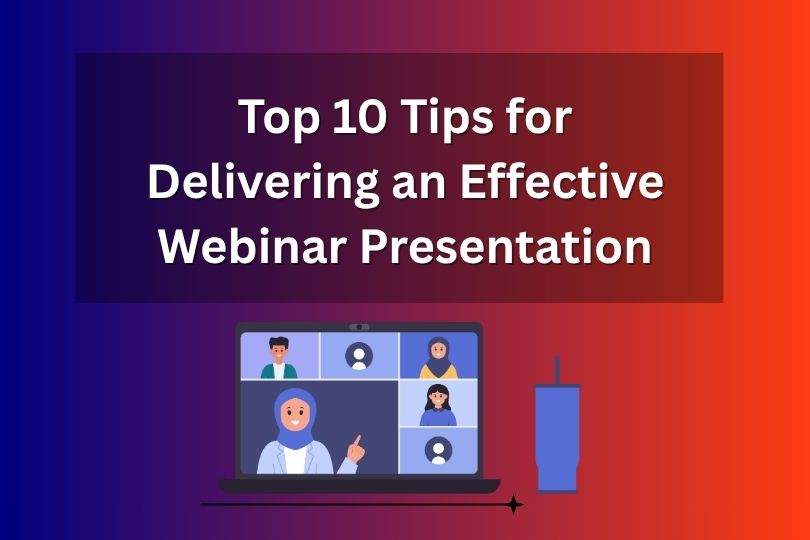

Introduction: Presentation Tips for Delivering an Effective Webinar
An effective webinar presentation is about connecting you to the screen and engaging the remote audience, guiding their attention, and delivering your message clearly with excellent visual support. Webinars face unique challenges as compared to in-room presentations, like you can’t see the full body language of your audience, attention may drift, and technical issues matter more. To win in that environment, you’ll want to apply smart presentation tips and sharp PowerPoint tips that keep your audience engaged, and you can deliver your message clearly.
In this article, RocketSlide will draw your attention to the broader landscape of slide creation and also make links to deeper content, so you can dive further into slide design and template choices. So now we are going to explore the 10 high-impact tips for webinar success.
What Makes a Great Webinar Presentation
Before starting with the tips, let's discuss some important things to understand what makes webinar presentations different from in-person sessions and why your approach needs to adapt.
In physical presentations, you have the advantage of energy, movement, and body language, but in a webinar, your voice, visuals, and timing are important. This means you should choose the strategic PowerPoint tips and design.
A great webinar should balance the three key elements:
- Clarity: Your slides communicate the key message clearly, and you can use visuals that enhance understanding.
- Connection: You can engage your audience through polls, questions, and storytelling.
- Consistency: From fonts to slide transitions, a consistent design keeps your presentation professional.
Now let’s discuss the Top 10 Tips for Delivering an Effective Webinar Presentation, which are practical, high-value strategies.
1. Strong Opening
Your webinar’s success depends on the first few minutes. Start with a hook, a bold question, or a story. Then clearly state the purpose of your presentation so your audience knows what they’re in for.
Slide tip: Use one clean slide for your main message and another for the purpose with just 3-5 bullets.
2. One Idea Per Slide
In remote settings, your audience’s attention span may be shorter. So here is a tip: you can limit each slide to one clear idea. Avoid long paragraphs, multiple charts, or distracting visuals.
Design tip: Choose slide templates that are clear and have white space. This keeps the focus on your message.
3. Use Visuals and Infographics
Visuals can elevate or destroy any presentation. Make sure to use images, icons, and charts that are directly related to your point, rather than for decoration. According to research, people process visuals and text differently, so combining them can make your presentation effective.
Design tip: Maintain a consistent palette and use clean typography to ensure your visuals are high-quality.
4. Keep Your Audience Involved
Webinars are more than one-way lectures; you can incorporate polls, chat, Q&A sessions, or breakout discussions. The goal is to keep your audience involved, not just listening.
Implementation tip: Every 10-15 minutes, you can use an engagement slide, which may be a quick poll, a question for chat.
5. Rehearse Your Content and Technology
One of the most overlooked webinar presentation tips is that rehearsing the content, not changing your speech, can affect your entire webinar setup. Test your mic, camera, screen sharing, transitions, and backup plans.
PowerPoint tip: Consider the “PDF to PPT” workflow if you receive material in PDF format and want to convert it into editable slides.
6. Choose Professional-Quality Templates
If you use any cool PowerPoint templates or go with a free PPT template download, it can dramatically improve your visuals and save you time, but the template should support the readability and structure of your brand message.
Tip: Once you select a template, customize fonts, colors, and icons to align with your brand.
7. Deliver Naturally
Even well-designed slides can fall apart if the delivery feels robotic. One of the most helpful presentation tips is to know your material well enough to speak freely rather than read word-for-word from slides.
Webinar tip: Since your audience may not fully see your body language, focus on your voice.
8. Manage Slide and Deliver on Time
In a webinar, delivery becomes even more important. A good rule of thumb is to aim for one slide per 1–2 minutes of talk. Allocate your time for introduction, content, engagement, wrap-up, and Q&A.
PowerPoint tip: Use the slide master to ensure consistent layouts and avoid last-minute formatting.
9. End with Clear Takeaways
At the end of your webinar, summarize the key points and provide next steps or resources. You might link to Google Slides tutorials or a downloadable deck.
10. Maintain a Clean Virtual Environment
Even the best-planned webinars can become worse. Test your internet, verify slide sharing works for participants, and check audio levels and lighting. Also, always have backups.
Design tip: Ensure your slide sequences make sense even if you need to skip a section or move faster.
For further reading on effective slide design, check out our blog post “5 Slide Hacks to Instantly Elevate Your Next Presentation.”
Conclusion
If you want to deliver an effective webinar, you must combine storytelling with strong visual design and thoughtful delivery. By using these top 10 tips, you put yourself in a strong position to succeed.
Using the right resources, like RocketSlide for creating the presentation, will save a lot of time and further boost your professionalism and efficiency.
Get the Latest Updates


